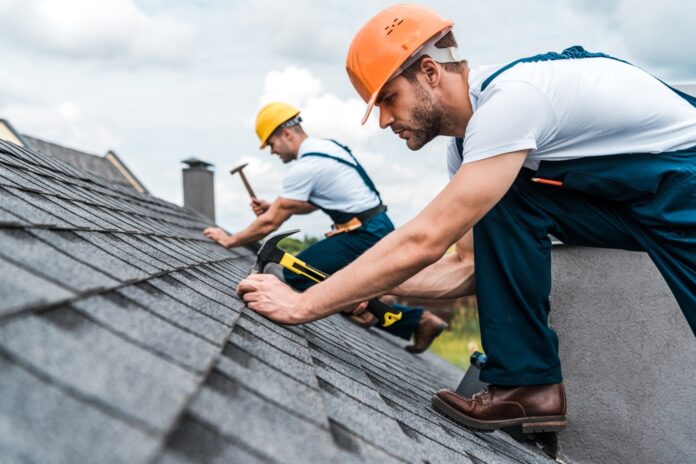It’s a mistake to assume that the shingles are what make up the entirety of your roof. However, some homeowners in Southlake really think that’s the case. The truth is it’s not: a complete roof system consists of several components. Each of them is actually there for a reason. Each of your roofing system’s elements has a purpose and is designed to add not only to the look but, more importantly, to the roof’s stability.
Simply saying, the essential roofing components in Southlake work together like one well-oiled machine. They deliver superior weather protection so your home can have lasting performance.
Whether you simply are looking to update your existing roof or intend to build one from scratch, you’ll want to learn more about its different vital components to ensure that your family gets the best protection. Check them out below.
1. Roof Sheathing
The roof sheathing is the roofing materials’ foundation. Southlake roofers apply the roofing materials over it. The roof sheathing acts as the link, uniting all roofing components together. That’s why it must be free from mold and wood rot. It must also be nail-able, dimensionally stable, and solid.
An inadequate substrate or roof sheathing causes many roof failures, including roof and shingle blowoffs. Yes, they’re not the fault of the shingle, contrary to popular belief.
The roof sheathing can be made of various high-quality materials as recommended by a professional roofer, including corrugated metal, wood tongue and groove, OSB sheathing, and plywood.
2. Trusses and Rafters
Your roof structure is made up of trusses, purlins, and rafters. These are the ones that support the sheathing. They are also made from treated wood. They toughen the roof structure and provide a nailbed for the shingles. Most often, trusses are triangular in shape. Rafters are laid side by side in series, while purlins are horizontal beams that support the roof.
Presently, most Southlake residents prefer trusses for their roofs as they are stronger and more cost-efficient compared to rafters. They also add an aesthetic value to your roof.
3. Underlayment
The underlayment, also known as felt, is made of synthetic material sheets that work as a waterproofing barrier. It may not be easily visible to the naked eye, but it is an essential part of your roofing system. They are installed over the roof’s plywood deck right before fastening the shingles. The underlayment serves as an added protection to prevent rain and other types of moisture from penetrating the ceiling.
Aside from that, it also protects the wood from the shingle’s chemicals. The sun’s heat can cause shingles to melt directly into the wood if there’s no underlayment in between, which then results in expensive roof repairs.
4. Flashing and Drip Edge
One of the most critical parts of your roof is the roof flashing. The flashing is responsible for securing joints in the roof, including other places that may receive plenty of water, such as valleys between slopes. Flashings are placed in order to direct water away from vulnerable roof areas, thus redirecting it into the gutters off the roof.
Chimneys, for example, don’t have underlayment or shingles. A chimney goes straight through the entire roof sheathing into your home. Since the chimney’s sides would be left bare, they’d have nothing to stop rushing water at the joints where the roof and the chimney meet – that’s where flashing comes in. Southlake roofers typically install it around roof vents, valleys, skylights, chimneys, vent pipes, and any vertical surface that’s intersecting with the roof’s plane.
The roof edges also have drip edges. They’re moldings that cover the roof’s edge, reducing water infiltration risks from any of your roof’s nooks and crannies. This type of flashing is attached to the roof sheathing directly above the underlayment and along the roof slope’s bottom. Roofers and manufacturers highly recommend drip edges, although the International Residential Code doesn’t necessarily require them.
There are different types of flashing. The common ones are vent pipe flashing, valley flashing, step flashing, continuous flashing, and drip edges. But overall, the flashing is made up of materials that cannot be penetrated by water easily, including composite materials, plastic, and metal (lead, stainless steel, aluminum, copper, etc.). Without these, your roof is prone to water leaks in the long run.
5. Ventilation
Excessive heat tends to build up in your attic, and ventilation prevents that from happening. Proper ventilation can keep your home thermally comfortable while preventing premature wear and tear from occurring on the roofing materials above.
As part of a roof system’s healthy functioning, a roof will breathe in the cool fresh air and exhale warm, moist air. The ventilation system is a series of openings, pipes, and vents that allow air to efficiently flow in and out of the attic space of your roof.
You may have excellent roof sheathing, quality shingles, installed roof flashing, and good quality underlayment; however, your roofing system will not perform as expected if the ventilation is not sufficient. Your roof’s lack of proper ventilation can cause serious problems such as mold and mildew, rust, sagging, roofing system deterioration, frost, and ice dams.
6. Roofing Material
The most frequent roofing material used in Southlake, or even in the entire United States, is the asphalt shingles, otherwise known as composition shingles. There are still plenty of options available for you to choose from, such as slate roofing, metal roofing, and wood shake. Below is a closer look at each of them:
- Asphalt shingles – Asphalt is widely available, comes in various colors, and is one of your least expensive roofing material options. Prices of asphalt shingles range from USD$70 to USD$120 per square.
- Slate – A sustainable roof that you can recycle, slate is very durable. It’s also fire-resistant. Prices of slate roofing start at about USD$600 per square and up.
- Metal – Metal roofing offers high solar reflectance. It’s also durable and can last longer than wood or asphalt roofing—prices of metal roofing range from USD$100 to USD$300. The high-end styles, however, can cost around USD$600 a square and up.
- Wood shake – This roofing material offers a rustic look. It’s a natural product that’s usually made from southern pine, redwood, and cedar. Prices of wood shake or wood shingles start at around USD$100 and can be up to USD$150 a square.
Final Thoughts
Investing in good quality and durable roof is your responsibility as a house owner. A robust roofing system protects you from any elements and will last for a long time, saving you more money and energy from expensive repairs and roof replacements.
To achieve a strong roofing system, you have to understand its important components. It will allow you to make all the best choices in meeting the needs and goals you have for your roofing installation or replacement project. You’ll get not only the best materials but also the best overall value for the money you’ll be spending. On top of it all, you’ll have peace of mind, knowing that you’re living under a sturdy roof.



















